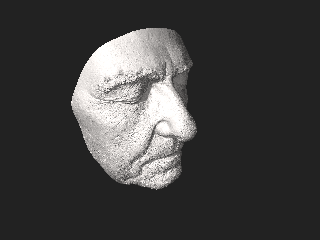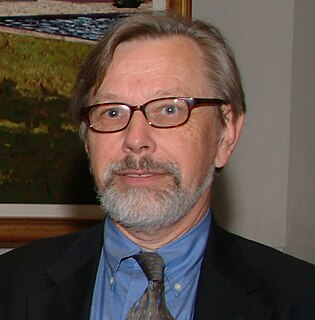
Motion capture is the process of recording the movement of objects or people. It is used in military, entertainment, sports, medical applications, and for validation of computer vision and robotics. In filmmaking and video game development, it refers to recording actions of human actors, and using that information to animate digital character models in 2D or 3D computer animation. When it includes face and fingers or captures subtle expressions, it is often referred to as performance capture. In many fields, motion capture is sometimes called motion tracking, but in filmmaking and games, motion tracking usually refers more to match moving.

A facial recognition system is a technology capable of matching a human face from a digital image or a video frame against a database of faces, typically employed to authenticate users through ID verification services, works by pinpointing and measuring facial features from a given image.

Gesture recognition is a topic in computer science and language technology with the goal of interpreting human gestures via mathematical algorithms. It is a subdiscipline of computer vision. Gestures can originate from any bodily motion or state but commonly originate from the face or hand. Current focuses in the field include emotion recognition from face and hand gesture recognition. Users can use simple gestures to control or interact with devices without physically touching them. Many approaches have been made using cameras and computer vision algorithms to interpret sign language. However, the identification and recognition of posture, gait, proxemics, and human behaviors is also the subject of gesture recognition techniques. Gesture recognition can be seen as a way for computers to begin to understand human body language, thus building a richer bridge between machines and humans than primitive text user interfaces or even GUIs, which still limit the majority of input to keyboard and mouse and interact naturally without any mechanical devices. Using the concept of gesture recognition, it is possible to point a finger at this point will move accordingly. This could make conventional input on devices such and even redundant.

Three-dimensional face recognition is a modality of facial recognition methods in which the three-dimensional geometry of the human face is used. It has been shown that 3D face recognition methods can achieve significantly higher accuracy than their 2D counterparts, rivaling fingerprint recognition.
Facial motion capture is the process of electronically converting the movements of a person's face into a digital database using cameras or laser scanners. This database may then be used to produce computer graphics (CG), computer animation for movies, games, or real-time avatars. Because the motion of CG characters is derived from the movements of real people, it results in a more realistic and nuanced computer character animation than if the animation were created manually.
Professor Hassan Ugail is a mathematician and a computer scientist. He is currently working as a Professor of Visual Computing at the School of Engineering and Informatics at the University of Bradford. Professor Ugail is the first Maldivian to obtain a PhD in Mathematics. He is also the first and to date the only Maldivian to receive a professorship in the field of Science.

Lennart Johnsson is a Swedish computer scientist and engineer.

The Roy G. Cullen Building is the oldest building on the present-day campus of the University of Houston. It is believed to be the first building on a campus of higher education in the United States with air conditioning. Construction for the building began in 1938, and was completed the following year.

Hugh Roy Cullen was an American industrialist and philanthropist. Cullen was heavily involved in the petroleum industry having struck oil near Texas in 1928. He was a large supporter of the University of Houston and longtime chairman of the board of regents for the university. He is considered one of the most important figures in Texas during the "oil boom" era.

The Lillie and Hugh Roy Cullen Sculpture Garden is a sculpture garden located at the Museum of Fine Arts, Houston (MFAH) in Houston, Texas, United States. Designed by artist and landscape architect Isamu Noguchi, the garden consists of 25 works of the MFAH, including sculptures by Henri Matisse, Alexander Calder, David Smith, Frank Stella, and Louise Bourgeois. There are also sculptures created specifically for the site, including Ellsworth Kelly's Houston Triptych and Tony Cragg's New Forms. The garden also features works by local Texas artists, including Joseph Havel's Exhaling Pearls, Jim Love's Can Johnny Come Out and Play?, and Linda Ridgway's The Dance.
In order to identify a person, a security system has to compare personal characteristics with a database. A scan of a person's iris, fingerprint, face, or other distinguishing feature is made and a series of biometric points are drawn at key locations in the scan. For example, in the case of a facial scan, biometric points might be placed at the tip of each ear lobe and in the corners of both eyes. Measurements taken between all the points of a scan are compiled and result in a numerical "score". This score is unique for every individual, but it can quickly and easily be compared to any compiled scores of the facial scans in the database to determine if there is a match.[citation needed]

The Department of Physics at the University of Houston is a department of the University of Houston College of Natural Sciences and Mathematics performing research traditional fields such as High Energy Physics and Condensed Matter Physics, Material Science, and Biological Physics, but also topics like Seismic and Medical Imaging. With its physics program, the University of Houston physics department placed 60 in the 2010 United States National Research Council rankings. The Department works together closely with the Texas Center for Superconductivity.
Arthur Weglein is an American seismologist. He is the Hugh Roy & Lillie Cranz Cullen distinguished professor of physics at the University of Houston, and director of its Mission-oriented Seismic Research Program. He received the Townsend Harris Medal of the City College of New York in 2008 for his contributions to seismology. He received the Reginald Fessenden Award of the Society of Exploration Geophysicists in 2010. He received the Maurice Ewing Medal of the Society of Exploration Geophysicists in 2016.
Badrinath "Badri" Roysam is an Indian-American professor and researcher. He is the current chairman of the Department of Electrical and Computer Engineering at the University of Houston Cullen College of Engineering. Dr. Roysam is notable as the creator of the FARSIGHT project, which is a collaborative effort to create an open source software toolkit to analyze multidimensional images. Roysam's work as a researcher focuses on cancer immunotherapy and neuroscience.
Sunčica Čanić is a Croatian-American mathematician, the Hugh Roy and Lillie Cranz Cullen Distinguished Professor of Mathematics and Director of the Center for Mathematical Biosciences at the University of Houston, and Professor of Mathematics at the University of California, Berkeley. She is known for her work in mathematically modeling the human cardiovascular system and medical devices for it.
Abdeldjelil "DJ" Belarbi is an Algerian-American Structural Engineer and Researcher whose research deals with the design, evaluation, and rehabilitation of reinforced and prestressed concrete bridges and buildings. He is currently the Hugh Roy and Lillie Cranz Cullen Distinguished Professor at University of Houston and previously a Distinguished Professor of Civil Engineering at Missouri University of Science and Technology.

Karl M. Kadish is an American chemist. He is currently Hugh Roy and Lillie Cranz Cullen University Professor at the University of Houston.
David J. Francis is an American psychologist, focusing in statistical models for longitudinal data, multi-level models, latent variable models, psychometrics, reading acquisition and the early identification and prevention of reading disabilities and developmental disabilities, currently the Hugh Roy and Hugh Roy and Lillie Cranz Cullen Distinguished University Chair at University of Houston.
Elena L. Grigorenko is an American clinical psychologist and the Hugh Roy and Lillie Cranz Cullen Distinguished Professor of Psychology at the University of Houston, where she has taught since September 2015. She is also a professor in the Department of Molecular and Human Genetics at Baylor College of Medicine.

The Hugh Roy and Lillie Cullen Building is the central administration building of Southwestern University in Georgetown, Texas. Completed in 1900, the Cullen Building was declared a Recorded Texas Historic Landmark in 1962 and has been listed on the National Register of Historic Places since 1975, together with neighboring Mood-Bridwell Hall.










